How U.S. Companies Are Using External Data to Make Smarter Decisions in 2025
From emerging trends and consumer behaviors to potential risks, external data allows companies to gain a holistic view of the market. Access to data and tools powered by artificial intelligence (AI) has shifted how businesses make strategic decisions, using data to accelerate business growth and operational efficiency.
Read on as we uncover how companies have seen measurable results and increased revenue, as well as the top red flags to watch out for.
Benediktas Kazlauskas
Jul 25, 2025
5 min read

How do businesses use external data in 2025?
To learn more about how external data and AI-powered tools are utilized to make smarter decisions, we surveyed 1,000 CEO and decision makers from across the U.S. to determine the state of data in America.
Using an online survey, we shared a selection of screen questions based on their position and whether they have any power over decision-making when it comes to data. We then screened out participants who were not in our sample size.
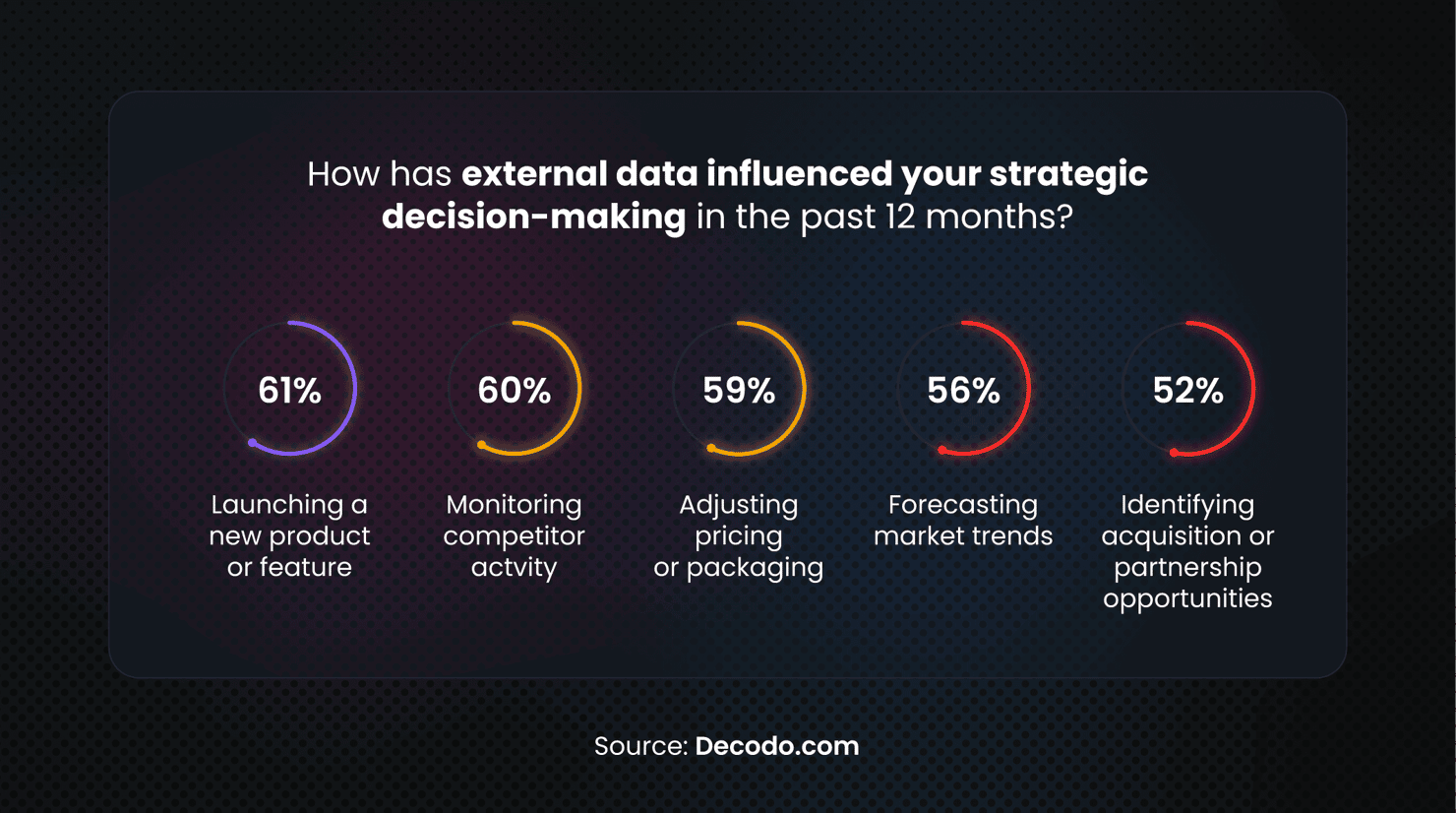
Almost 9 out of 10 respondents (94%) were full-time employees, with the majority working in the technology sector (66%). All of our respondents played key roles in areas such as IT, as well as HR (19%), procurement (17%), customer services (16%) and sales (14%).
Almost a third (32%) of our respondents were at C-suite level, featuring survey answers from the likes of Chief Executive Officers, Chief Financial Officers, Chief Operating Officers, Chief Marketing Officers, and Chief IT Officers.
Meanwhile, 35% of our survey participants were senior managers and decision makers, including responses from Senior Vice Presidents, Directors and heads of departments. Of the 12% who identified as business owners and managing directors, over half (57%) were self-employed.
Social media and UGC are the most popular external data sources used by companies
When asked what types of external or public data sources they rely on most, two-thirds of businesses said that social media and user-generated content (UGC) were their main resources.
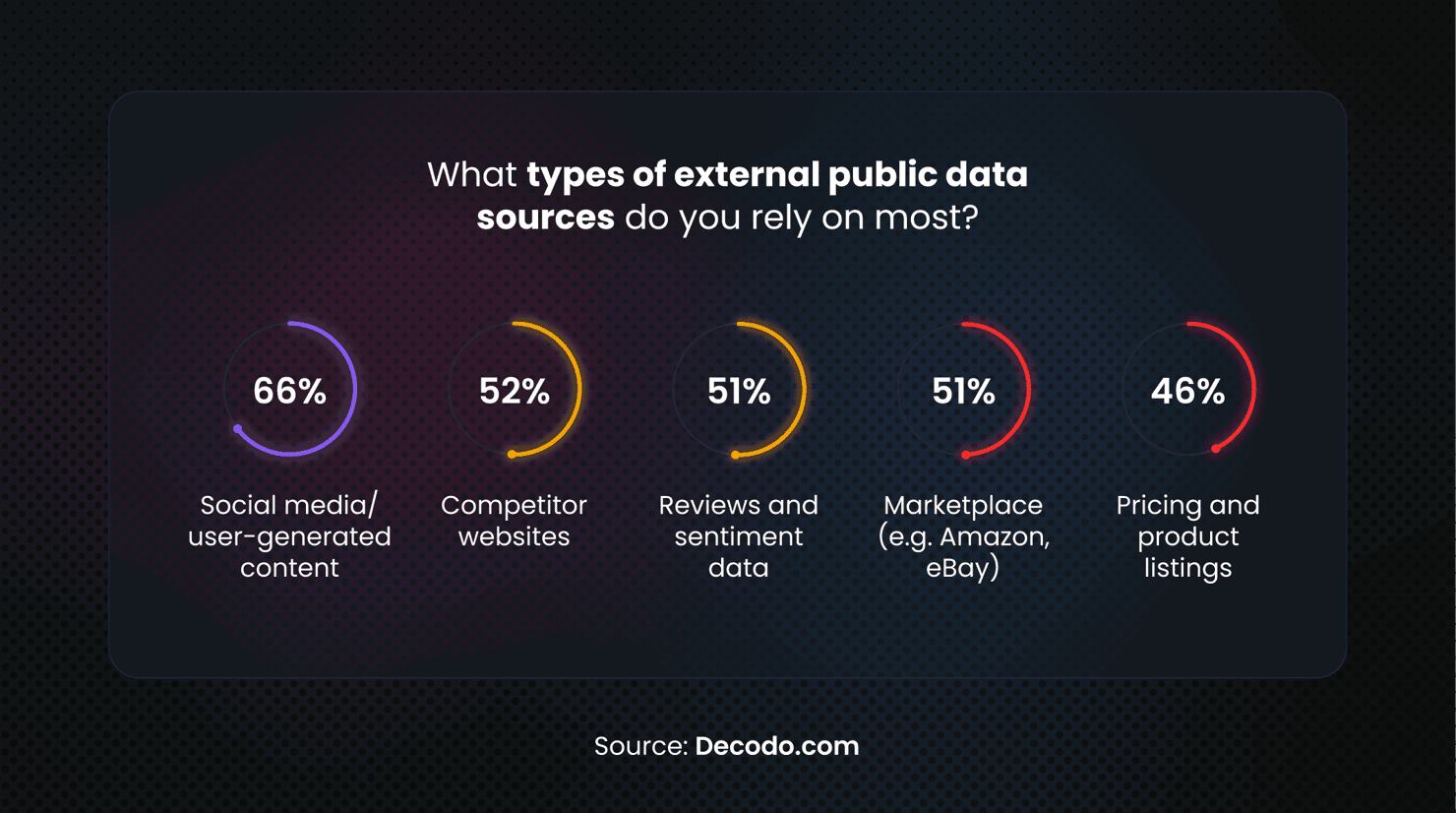
Meanwhile, over half of U.S. businesses utilize competitor websites (52%), reviews and sentiment data (51%), and marketplaces like Amazon and eBay (51%) to support their business strategy. The next most popular sources are price change alerts and product listings (46%). Monitoring competitors for new product releases and website changes helps companies keep their finger on the pulse, assessing potential advantages and evaluating gaps in their own strategy.
“We’re increasingly relying on real-time data streams and advanced analytics platforms to make faster, smarter decisions in response to rapid market changes,” an anonymous Director of Technology explained.
Justinas Tamaševičius, Head of Engineering at Decodo, comments: “To really understand the market and react accordingly, it’s crucial to track what customers are saying about competitors too. With the right tools and the right setup like web scrapers, parsers, and geo-distributed proxies businesses can extract review data at scale, track sentiment over time, and even surface regional preferences or emerging feature requests.”
Almost two-thirds of businesses use external data to launch new products
When it comes to being data-driven, businesses face increasing pressure to remain competitive. We explored how businesses in the U.S. use external data and AI to their advantage, supporting their strategic decision-making.
Our data shows that AI is one of the key drivers of business innovation. Almost two-thirds (61%) of businesses in the U.S. used external data to launch a new product or feature in the last year.
Meanwhile, a large proportion of businesses also use external data to monitor competitor activity (60%) and adjust their pricing or packaging (59%).
Over half use external data to help forecast market trends (56%) and identify acquisition and partnership opportunities (52%), helping businesses make more informed decisions.
“We plan to leverage AI and external data sources more extensively to sharpen decision-making, streamline workflows, and gain a competitive edge,” summarized a Chief IT Officer in our survey.
Key business results driven by external data
According to our survey, an overwhelming majority of businesses have seen measurable business results from using external data and AI tools.
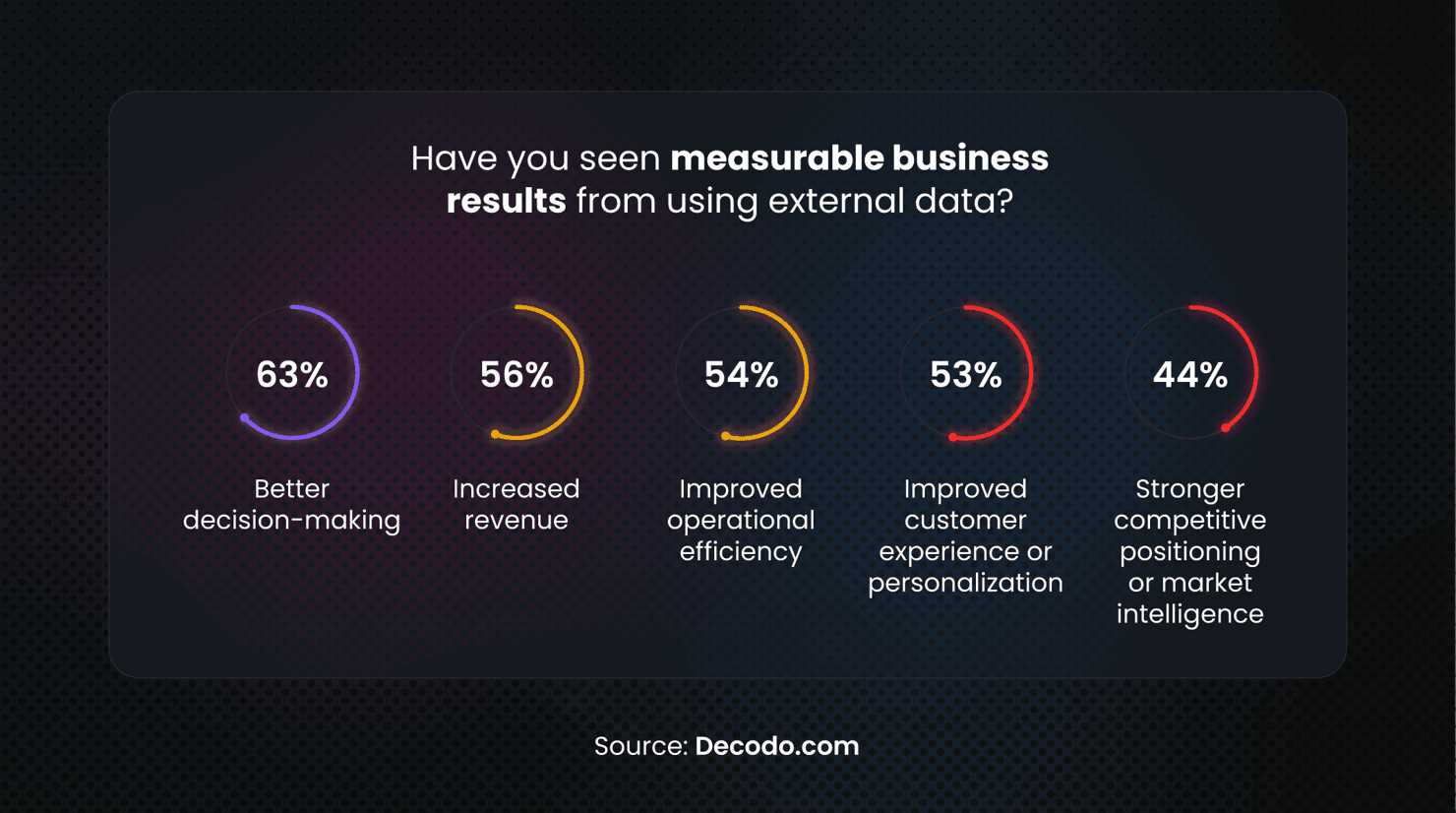
- Almost six in 10 (63%) businesses report better decision-making.
- More than half of businesses report increased revenue (56%) and improved operational efficiency (54%).
- Over half of businesses saw customer experience or personalization improvements (53%).
- More than 4 in 10 (44%) businesses gained a stronger competitive positioning or market intelligence.
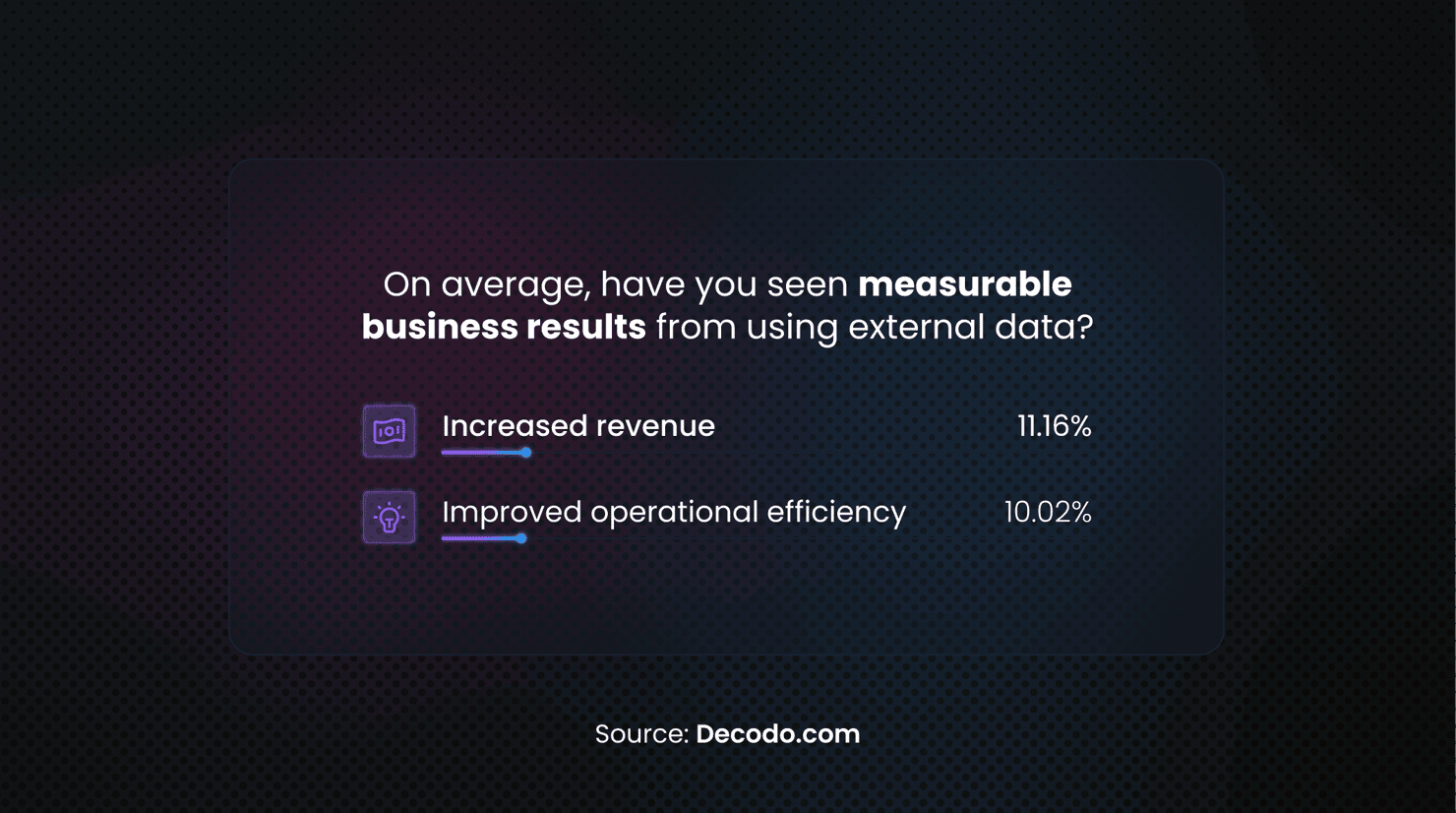
“We anticipate increased use of AI and external data to gain a competitive advantage, particularly across our accounting and finance functions,” one CFO shared in our survey.
Thanks to external data, the majority of businesses saw revenue increases of 6 to 10% (48%), with a third (33%) driving an increase of 11 to 20%. Meanwhile, one in 12 businesses (8%) report increased business revenue figures of more than 21%.
As for boosting operational efficiencies, most U.S. businesses report improvements between 6 and 10% (48%), while a quarter see benefits between 11 to 20%. Only 7% of businesses achieve workflow improvements exceeding 21%.
“Businesses need visibility into what’s happening beyond their own walls,” Vytautas Savickas, CEO at Decodo, comments. “Public data like competitor pricing, customer reviews, social sentiment, and market trends gives businesses the context they need to adapt quickly and make smarter decisions. The businesses that are thriving aren’t just watching the market – they’re reading it in real time.”
1 in 4 companies have built proprietary AI tools to stay competitive
We know that AI integration can help businesses capitalize on industry trends and market demands. And according to our survey, most companies have embraced AI as an integral part of their workflows.
“We’re planning a major expansion in our use of AI and external data to boost decision-making, fuel growth, and stay ahead in an increasingly competitive environment,” one CEO stated.
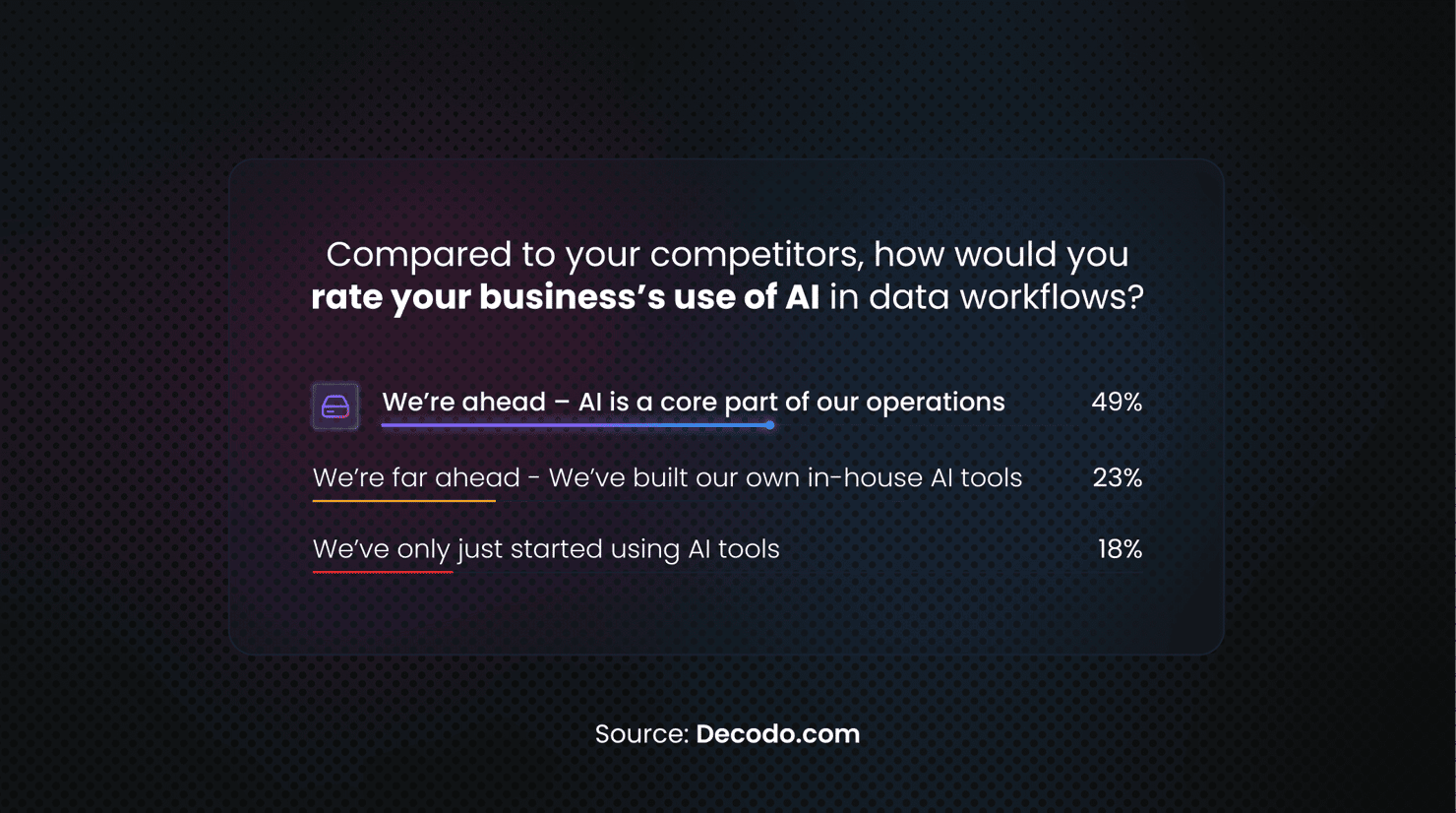
Likewise, almost half (49%) of U.S. companies said that AI is a core part of their business operations. Meanwhile, almost 1 in 4 (23%) boosted their competitive edge by building proprietary in-house AI tools.
But if your business is unsure where to begin, you’re certainly not alone. Almost 1 in 5 (18%) businesses report to be at the start of their AI journey and are yet to fully integrate AI tools.
Key business metrics improved by using external data
To find out how external data could help improve key performance indicators (KPIs), we asked U.S. businesses to reveal the top business metrics accelerated by data usage.
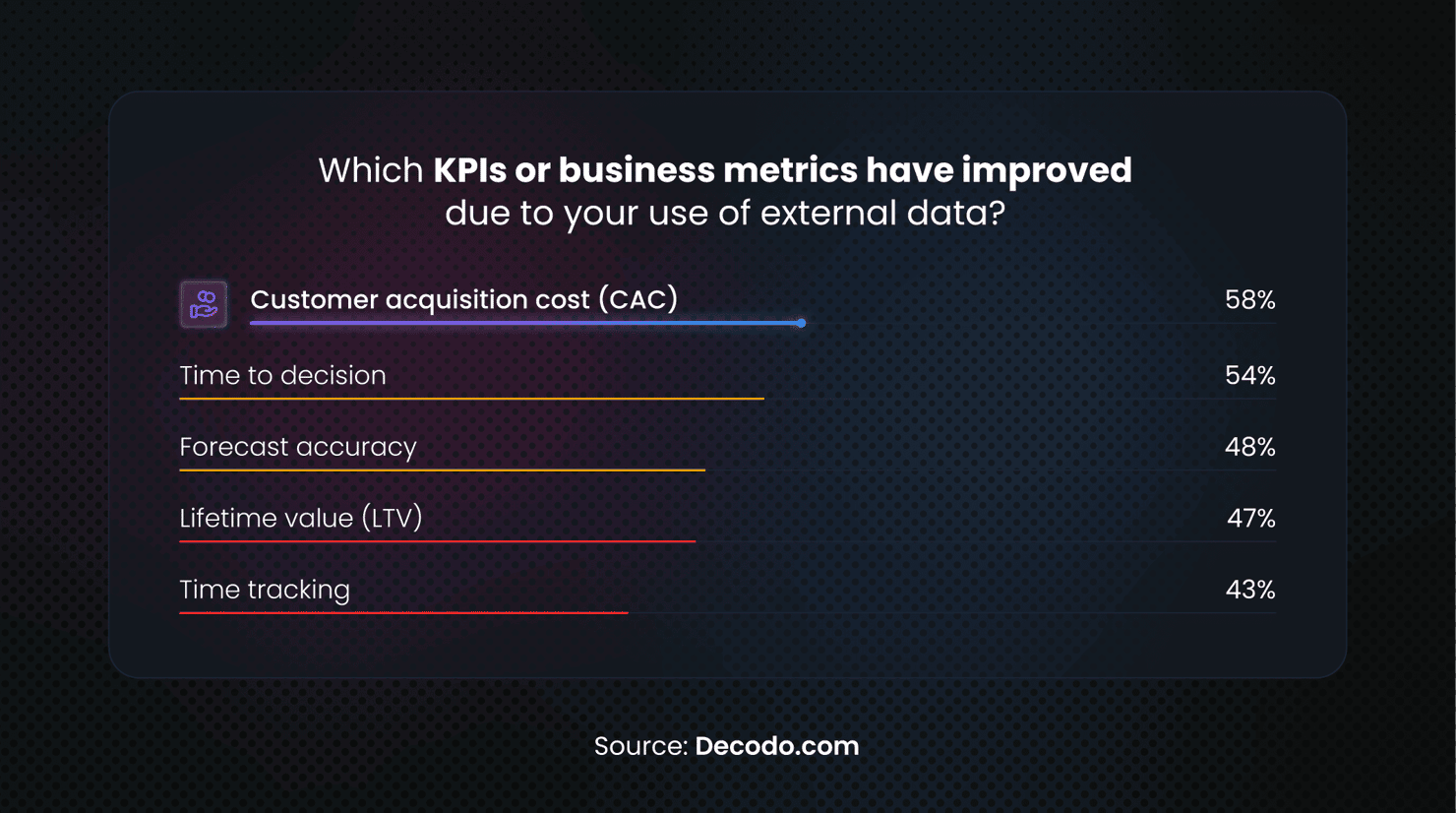
- Almost 3 in 5 (58%) businesses report improved customer acquisition costs (CAC).
- More than half (54%) report improved time to decision.
- Almost 5 in 10 (48%) have seen enhanced forecast accuracy.
- 47% report improved lifetime value (LTV).
- Over 4 in 10 businesses (43%) report improvements in time tracking.
“We’re investing in AI and external data integration to support strategic decision-making and accelerate business growth,” shared an anonymous CFO and survey contributor.
Common obstacles to accessing external data
To help companies anticipate and mitigate challenges, we uncovered some of the most common roadblocks businesses face when retrieving external data.
According to our survey, the top barrier preventing access to external data is budget and resource constraints, affecting 37% of businesses in the U.S.
Around a third of businesses struggle with issues such as IP blocks, geo-restrictions (33%), and CAPTCHAs (29%). However, other businesses find that they’re obstructed by their limited internal infrastructure (29%).
Almost 3 in 10 (29%) are held back by a lack of technical expertise and poor or inconsistent data quality. Meanwhile, more than 1 in 6 (16%) are blocked by unclear ROI or weak business cases.
How to overcome obstacles safely: tips from our experts
“While high-quality data often comes at a cost, choosing a trusted provider ensures safer, more reliable solutions that pay off in the long run,” Vaidotas Juknys, Head of Commerce at Decodo explains. “One easy way to save money without losing quality is by comparing providers. We suggest choosing a provider that offers rotating residential IPs instead of large, cheap pools because this helps prevent your requests from getting blocked and saves you time. Good providers also offer built-in error handling and support, so your team spends less time fixing issues.”
As for overcoming IP blocks, geo-restrictions, and CAPTCHAs, our experts recommend using a combination of smart technology and global infrastructure.
“It’s not just about bypassing roadblocks – it’s about doing it right,” says Justinas Tamaševičius, Head of Engineering at Decodo. “We’ve seen companies get blocked or flagged because they’re using outdated tools, unreliable free proxies, or aggressive scraping tactics. That’s risky. At Decodo, we use proxies with ethically sourced IPs that simulate real user behavior and distribute requests in a way that’s both effective and compliant.”
6 in 10 businesses utilize external data to optimize business strategy
As one Chief Product Officer reports, AI is pushing boundaries and transforming the landscape, whether you take part or not: “I definitely think our data usage will rise – things are moving quickly with AI, and we’re leaning more on external data to stay ahead and make better calls.”
When asked where external data delivers the most value, businesses identified the following areas:
- More than two-thirds (62%) reported that external data benefits business strategy the most.
- Over half (54%) said product development.
- 54% of companies saw improvements in marketing and customer acquisition.
- 52% of businesses said external data has improved competitive intelligence.
- More than 4 in 10 (41%) reported improved sales enablement.
- 40% of companies report that external data supports risk and fraud detection.
- One-third of businesses (30%) reported improved supply chain and logistics.
Data breaches and unverifiable sources: top red flags to look for
While integrating external data is a priority for many CEOs in the US, it’s also important to understand the potential risks. The structure, quality, and reliability of external data can vary widely.
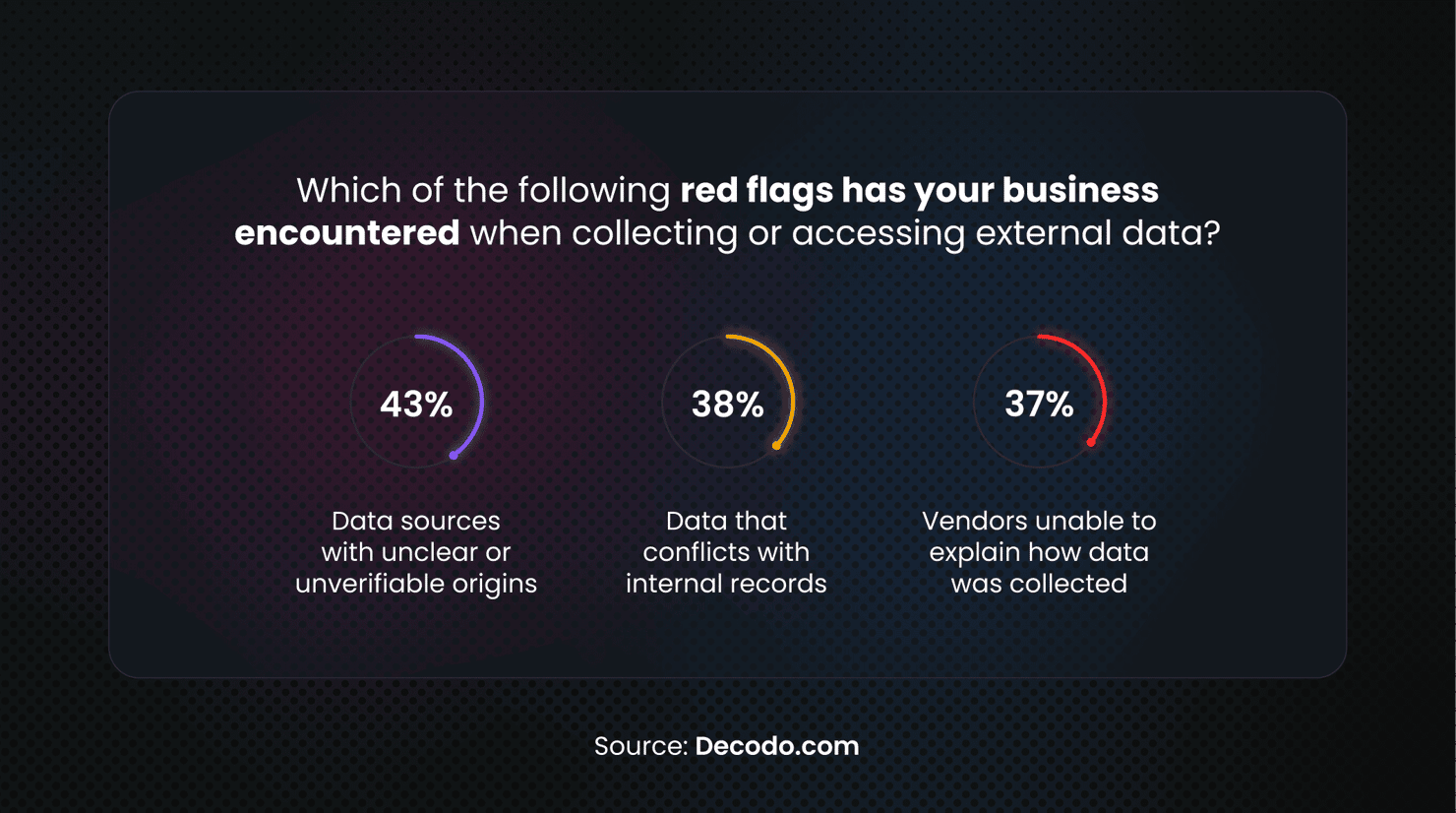
We uncovered the most common red flags encountered by businesses when collecting or accessing external data:
- Faced by 43% of U.S. businesses, data sources with unclear or unverifiable origins were the most common risks.
- Almost 2 in 5 (38%) businesses revealed that data can pose compliance risks, conflicting with internal records.
- Over a third have faced data breaches (35%), as well as outdated or incomplete datasets (34%).
Meanwhile, other concerns included lost data (23%), tools or scrapers breaking without explanation (22%), and unexpected IP blocks or geo-restrictions (22%).
“Companies that rely on data to drive decisions need to be confident in its accuracy and relevance,” explains Gabrielė Verbickaitė, Product Marketing Manager at Decodo. “That starts with thoughtful due diligence – verifying information across multiple trusted sources and putting strong review processes in place. AI-powered validation tools can add another layer of assurance by quickly identifying gaps or inconsistencies. And when selecting a data provider, looking into their reputation and track record for data quality can save a lot of time and money.”
Methodology
This survey was conducted by the independent research agency 3Gem between June 23rd and July 5th, 2025. It gathered responses from 1,000 C-level executives and senior decision-makers across the United States, spanning various industries, including technology, finance, retail, and professional services.
Respondents were selected according to strategic decision-making roles within their organizations, including titles such as CEO, CFO, CTO, CMO, Managing Director, and Founder.
The sample was nationally representative by company size (from SMEs to large enterprises) and was weighted to ensure balanced insights across sectors and regions. Data was collected online via structured questionnaires using a mix of multiple-choice and open-ended questions to provide both quantitative and qualitative insights.
Discover essential business solutions with Decodo
As businesses integrate more AI-powered tools and analytics platforms, it’s important for them to utilize both internal and external data to help streamline workflows and accelerate business growth. However, to help mitigate risks, vetting your data sources is vital.
Don’t let your resources limit your business potential. Benefit from award-winning and ethically sourced IPs worldwide with Decodo. Browse our accessible price plans for access to our all-in-one Web Scraping API data collection solution. Collect data from websites without facing CAPTCHAs, IP bans, geo-restrictions, and other roadblocks.
We offer a reliable infrastructure for launching, testing, and scaling web data projects. Join our growing network of 85K+ global users and see how our tools and templates could help streamline your workflows.
Grow your business with real-time data
Get started with a 3-day free trial of awarded residential proxies – avoid CAPTCHAs, IP blocks, and geo-restrictions.
About the author

Benediktas Kazlauskas
Content Team Lead
Benediktas is a content professional with over 8 years of experience in B2C, B2B, and SaaS industries. He has worked with startups, marketing agencies, and fast-growing companies, helping brands turn complex topics into clear, useful content.
Connect with Benediktas via LinkedIn.
All information on Decodo Blog is provided on an as is basis and for informational purposes only. We make no representation and disclaim all liability with respect to your use of any information contained on Decodo Blog or any third-party websites that may belinked therein.

